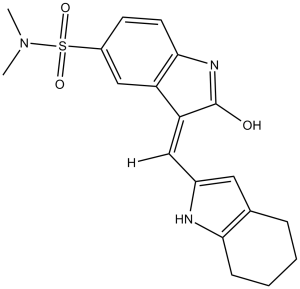This product is for research use only, not for human use. We do not sell to patients.

| Size | Price | Stock |
|---|---|---|
| 250mg | $750 | Check With Us |
| 500mg | $1150 | Check With Us |
| 1g | $1725 | Check With Us |
Cat #: V0669 CAS #: 330161-87-0 Purity ≥ 98%
Description: SU 6656 (SU-6656) is a novel, potent and selective Src family kinase (Src, Yes, Lyn, and Fyn) inhibitor with potential antineoplastic activity. It inhibits Src, Yes, Lyn, and Fyn with IC50 of 280 nM, 20 nM, 130 nM, and 170 nM respectively. SU6656 modulates CTGF (connective tissue growth factor) expression in an ERK-dependent manner. SU6656 induces caspase-independent cell death in FRO anaplastic thyroid carcinoma cells and therapeutic synergy in human synovial sarcoma growth, invasion and angiogenesis in vivo. In NIH 3T3 cell, SU6656 inhibits PDGF-/Src-driven mitogenesis and PDGF-stimulated c-Myc induction.
References: [1]. Blake RA, et al. SU6656, a selective src family kinase inhibitor, used to probe growth factor signaling. Mol Cell Biol. 2000 Dec;20(23):9018-27.
Publications Citing InvivoChem Products
Product Promise

- Physicochemical and Storage Information
- Protocol
- Related Biological Data
- Stock Solution Preparation
- Quality Control Documentation
| Molecular Weight (MW) | 371.45 |
|---|---|
| Molecular Formula | C19H21N3O3S |
| CAS No. | 330161-87-0 |
| Storage | -20℃ for 3 years in powder formr |
| -80℃ for 2 years in solvent | |
| Solubility In Vitro | DMSO: 74 mg/mL (199.2 mM)r |
| Water: <1 mg/mLr | |
| Ethanol: <1 mg/mL | |
| Solubility In Vivo | 10% DMSO+dd H2O: 16 mg/mL |
| SMILES Code | O=S(C1=CC2=C(NC(/C2=C\C(N3)=CC4=C3CCCC4)=O)C=C1)(N(C)C |
| Synonyms | SU 6656; SU-6656; SU6656 |
| Protocol | In Vitro | In vitro activity: In NIH 3T3 cells, SU 6656 inhibits the PDGF-stimulated S-phase induction with IC50 of 0.3-0.4 μM. SU 6656 also inhibits PDGF- and serum-mediated NIH 3T3 cell proliferation, as well as epidermal growth factor and colony-stimulating factor 1-stimulated DNA synthesis in normal and colony-stimulating factor 1 receptor transfected NIH 3T3 cells. SU6656 inhibits PDGF-stimulated c-Myc induction and ERK2 activation. Pretreating Jurkat T-cells with SU 6656 leads to increased VSV-G luciferase activity. SU 6656 impairs TGF-β-mediated upregulation of CTGF mRNA and protein in proximal epithelial HKC-8 cells, and also reduces CTGF expression in cells exposed to autocrine growth factors. SU 6656 interferes with Aurora kinase activity resulting in inhibition of cell division and formation multilobular nuclei. Kinase Assay: IC50 measurements are made using poly-Glu–Tyr (4:1), or, in the case of Lck, poly-Lys–Tyr (4:1) as a peptide substrate. The divalent cation is 20 mM MgCl2 (in the case of Src, Fyn, Yes, Lyn, Csk, Frk, or Abl) or 10 mM MnCl2 (in the case of FGFR1, IGF1R, Lck, or Met). The final ATP concentrations are as follows: Src, 10 μM; Fyn, 6 μM; Yes, 100 μM; Lyn, 2 μM; Csk, 10 μM; Frk, 10 μM; Abl, 4 μM; FGFR1, 10 μM; IGF1R, 2 μM; Lck, 2 μM; Met, 5 μM; PDGFR, 6 μM. IC50 measurements of PDGFRb autophosphorylation are determined on immunoprecipitated PDGFRb. Km values are calculated using the Eadie-Hofstee method. Cell Assay: HKC-8 cells are seeded at different cells densities (10,000 cells/cm2 and 50,000 cells/cm2) and cultured in the presence or absence of SU 6656 for 24 and 48 h. Bright field pictures of cells are recorded by Olympus CK40 microscope using Leica DC Viewer software. |
|---|---|---|
| In Vivo | SU 6656 markedly and dose-dependently attenuates mecamylamine-induced experimental nicotine withdrawal syndrome in mice measured in terms of WSS and anxiety score. Once-daily administration of SU 6656 (1.5, 3, and 6 mg/kg, i.p.) markedly and dose-dependently attenuates the naloxone-induced morphine withdrawal syndrome. | |
| Animal model | Inbred Swiss albino male mice | |
| Formulation | 10% DMSO in water | |
| Dosages | 1.5, 3, and 6 mg/kg; i.p. injection |
| Solvent volume to be added | Mass (the weight of a compound) | |||
|---|---|---|---|---|
| Mother liquor concentration | 1mg | 5mg | 10mg | 20mg |
| 1mM | 2.6922 mL | 13.4608 mL | 26.9215 mL | 53.8430 mL |
| 5mM | 0.5384 mL | 2.6922 mL | 5.3843 mL | 10.7686 mL |
| 10mM | 0.2692 mL | 1.3461 mL | 2.6922 mL | 5.3843 mL |
| 20mM | 0.1346 mL | 0.6730 mL | 1.3461 mL | 2.6922 mL |
This equation is commonly abbreviated as: C1 V1 = C2 V2
- (1) Please be sure that the solution is clear before the addition of next solvent. Dissolution methods like vortex, ultrasound or warming and heat may be used to aid dissolving.
- (2) Be sure to add the solvent(s) in order.







































